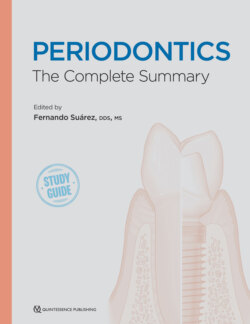Читать книгу Periodontics - Fernando Suarez - Страница 56
Chronic Periodontitis
ОглавлениеBased on the 2017 World Workshop on the classification of periodontal and peri-implant diseases and conditions, three forms of periodontitis are recognized: necrotizing periodontitis; periodontitis (formerly known as chronic and aggressive periodontitis); and periodontitis as a manifestation of systemic diseases.61 However, for the purpose of this chapter, both chronic and aggressive periodontitis are discussed separately.
Periodontitis was recently defined by the 2017 World Workshop as a “chronic multifactorial inflammatory disease associated with dysbiotic plaque biofilms and characterized by progressive destruction of the tooth-supporting apparatus.”1 The main features of this disease include the presence of periodontal pockets, gingival bleeding, clinical attachment loss, and alveolar bone loss (Fig 3-3). If left untreated, periodontitis could lead to tooth mobility and ultimately tooth loss. In addition, chronic periodontitis is influenced by a great variety of local and systemic factors that can significantly exacerbate disease progression. These factors are discussed in the following chapters.
Fig 3-3 Periodontitis (formerly referred to as chronic periodontitis.) (a) Initial presentation of maxillary and mandibular anterior dentition prior to nonsurgical therapy. (b) Radiographic evaluation prior to nonsurgical therapy. (c) Reevaluation 3 months after nonsurgical therapy.
As mentioned previously, periodontitis is caused by an exaggerated inflammatory response from the host caused by a dysbiosis. This process is the result of a transition from the symbiotic microbial and immune state of a healthy individual (or nonprogressive gingivitis) to an abnormal and exacerbated host response accompanied by a dysbiotic microbiome.62 It is important to mention that while gingivitis may or may not advance to periodontitis, attachment loss and the development of periodontitis are always preceded by gingival inflammation.63 Consequently, many authors have studied the changes and progression from gingivitis to periodontitis. In 1985, Listgarten et al64 longitudinally followed 61 adults with varying degrees of gingivitis. Results from this investigation revealed that only 1 out of 1,000 tooth surfaces increased in probing depths by 3 mm or more from baseline regardless of the protocol for recall maintenance intervals. Therefore, the authors concluded that despite the high prevalence of gingivitis, most individuals were relatively resistant to periodontitis. Subsequently, other investigations aimed at studying disease development, disease progression, and several other parameters related to periodontitis, such as attachment loss or changes in bone level.
Löe et al65,66 conducted a series of landmark investigations aimed at studying the natural development and progression of periodontal disease. One of the first investigations was published by this group in 1978 and compared two populations with different geographic, cultural, socioeconomic, and educational differences. Both groups were chosen due to the extreme differences with regard to health care systems and dental care. The study population from Oslo, Norway, had access to programs for dental care while the population from Sri Lanka never had access to any programs for prevention or treatment of dental-related diseases and did not perform toothbrushing. Results from this investigation demonstrated the variability with regard to disease progression between both populations, concluding also that without proper dental care, the periodontal lesions continue progressing at a relatively even pace.65 Years later in 1986, after following a group of 480 male Sri Lankan tea workers for 15 years, Löe et al66 described three subpopulations presenting with (1) rapid progression, (2) moderate progression, and (3) no progression of periodontal disease (Table 3-1). Results from this investigation demonstrated that disease progression varies between individuals, at different ages, as well as within the same individual dentition. Also, the authors explained that although disease progresses steadily over time, there may be discrete episodes with more rapid or slower destruction. In agreement with these results, a recent systematic review by Needleman et al67 concluded that mean attachment level change differs significantly within and between populations.
TABLE 3-1 Characteristics of the groups described by Löe et al66 in 1986
NA, not available.
